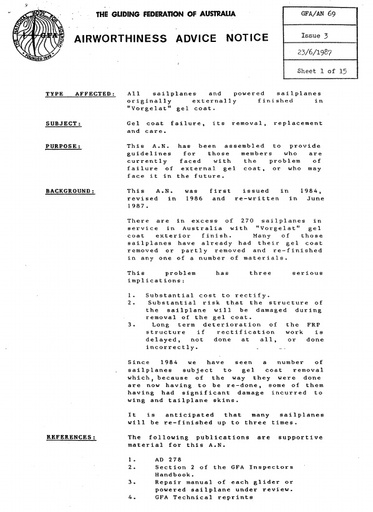pdf Gfa 069an Popular
By Tim Shirley Tagged in Various 2892 downloads
gfa_069an.pdf

GELCOAT FAILURE
Failure of the Gelcoat surface finish as supplied by many manufacturers is one of the major problems confronting the owners of FRP sailplanes. This problem has been made worse by poor refinishing work which has meant that many aircraft have required refinishing a second time. GEL COAT....A HISTORY OF ITS BREAKDOWN - In 1982 the Materials Research Laboratories were provided with gelcoat samples taken from sailplanes being re-finished due to gel coat failure. The results of the MRL research were used to prepare Issue 1 of this AN. AN 69 was written on the basis that we expected gel coat failure cracks would "transfer", causing cracking in the glass/epoxy layers under the gel coat. What was not known was how long it would be before we saw that cracking develop. Late 1985 early 1986, two professional workshops found clear evidence of crack propagation from the bottom of the gel coat into and through the top skins of a Hornet wing, Mosquito wing and Cirrus 75 tailplane. Samples were taken from the Hornet and Cirrus and sent to the DOA laboratory in Canberra for microscopic examination to try to establish the mechanism of this crack transfer. It must be noted that at June 1987 the "cracking" seems restricted to the epoxy resin in the skins, the question being - how long can cracked gel coat be left before it will induce glass or carbon fibre breakdown? Bluntly we are generally looking at potential structural damage, due to gel coat cracks, within 8 to 15 years from date of manufacture, if rectification action is not taken. Sailplanes originally finished in "Vorgelat" gel coat have suffered cracking and breakdown failure as outlined in (1)a and (1)b above. Sailplanes originally finished in "SCHWABALAC" have not experienced that type of failure up to 1987. "Chalking" of the surface if not kept polished, is common. Strain failure and cracking along filled joint lines is common in both.

